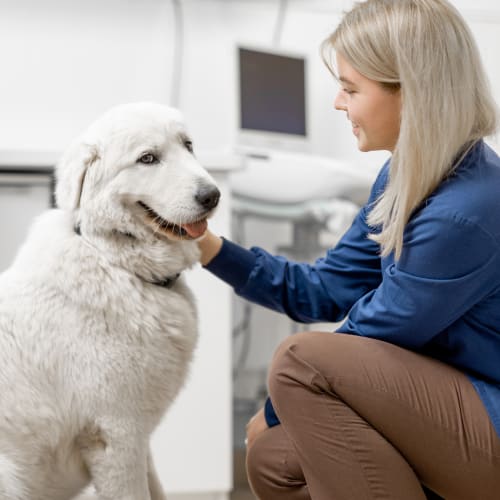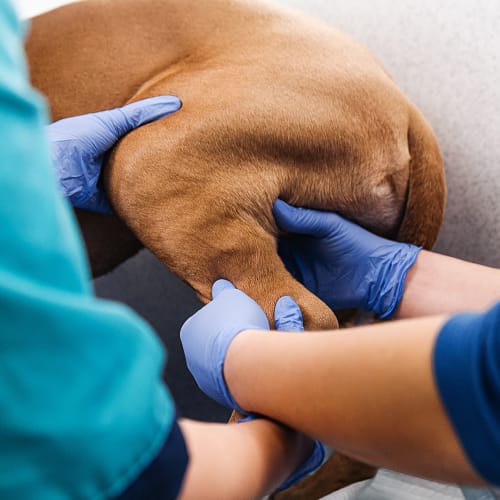Patellar Groove Replacement
Restoring Your Dog's Pain-Free Mobility
Patellar groove replacement surgery at Carolina Veterinary Specialists in Charlotte, can be an effective way to relieve your dog's knee pain and restore their zest for life.
Please Note: We require a referral from your primary care veterinarian before making an appointment for surgery.
Book an Appointment
Why Does My Dog Need Patellar Groove Replacement (PGR)?
If your dog's knees are healthy, as they walk or run the patella (kneecap) will travel effortlessly along the patella groove, located at the bottom of your pup's thighbone.
Patellar luxation is a degenerative condition characterized by the kneecap popping out of the patellar groove, resulting in immediate pain, ongoing deterioration of the patellar groove, and the development of osteoarthritis.
A PGR device surgically implanted by our board-certified veterinary surgeons restores the patellar groove, providing increased stability and, in many cases, eliminating knee pain.
Depending on the severity of your dog's knee issue, when combined with other restorative techniques, PGR can help to relieve immediate discomfort as well as prevent the development of further knee issues.
Board-Certified Veterinary Surgeons
At Carolina Veterinary Specialists we provide pets with advanced diagnostics and treatment not typically available at a standard veterinary clinic, including complex orthopedic surgeries. From pre-surgery assessments to surgery and follow-up, our team of board certified surgeons have the expertise and training necessary to provide your beloved pet with unparalleled care.
What is Patellar Groove Replacement?
Patellar groove replacement (PGR) is a partial joint replacement surgery that can be used to address knee pain in dogs caused by degenerative joint disease or patellar luxation.
- What conditions can PGR treat?
Patellar groove replacement can help to improve knee function and relieve pain caused by a variety of conditions including severe femoro-patellar osteoarthritis, patellar luxation, degenerative joint issues affecting the knee, and cranial cruciate injuries.
- What is the PGR surgical process?
The patellar groove replacement process involves replacing the damaged trochlear groove of your dog's knee with a prosthesis (the PGR device).
Once your dog has been comfortably anesthetized, our experienced veterinary surgeons will begin the process by removing the diseased or damaged groove to leave a flat, healthy bed of bone on which to anchor the PGR device.
After a healthy bed has been prepared, a metal plate will be screwed to the bone, and the PGR device will be secured to the plate.
As the area heals, the bone will bind to the plate ensuring long-term stability of the knee.
- What is the PGR device?
The PRG device is a state-of-the-art prosthetic trochlea groove that can be used to replace a damaged or diseased groove.
The trochlea groove is located on the top of your dog's femur (thigh bone), at the knee. In a healthy knee, the trochlea groove allows the kneecap to travel up and down as your pet walks or runs.
By replacing your pup's damaged bone with a PGR device, our veterinary surgeons can help to restore your dog's normal pain-free function.
- Is PGR surgery safe for dogs?
All surgical procedures, whether performed on people or pets, come with risks. Our team of specialists take every precaution in order to help ensure the safety of your pet.
Prior to surgery, your dog's overall health will be assessed in order to ascertain that your companion is fit enough to undergo surgery.
Throughout the surgical process, your beloved pet's vital signs will be continuously monitored using our state-of-the-art monitoring equipment (EKG, end tidal CO2, pulse oximetry, oscillometric blood pressure, arterial line, etc.).
- How long is the recovery following PGR?
A key advantage of PGR over other surgeries traditionally performed to address these knee issues, is the reduced recovery time.
It is essential to follow your veterinary surgeon's post operative care instructions carefully, and attend scheduled follow-up examinations to ensure the best possible results from your pup's PGR surgery.
A two-week period of very restricted activity will be necessary, followed by the introduction of five-minute leash walks at the week three period.
After receiving the all-clear from your veterinarian, your dog should be able to return to normal activity about eight to ten weeks after their surgery.

